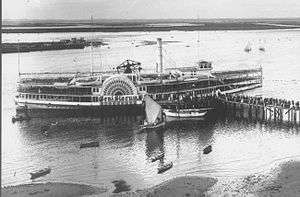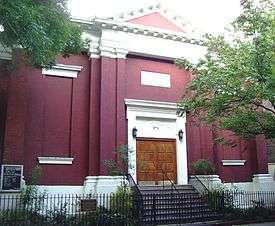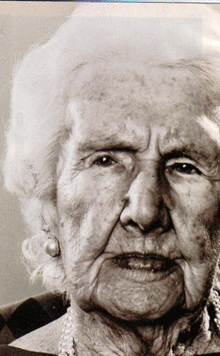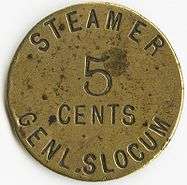PS General Slocum
 | |
| History | |
|---|---|
| Name: | General Slocum |
| Namesake: | Henry Warner Slocum |
| Owner: | Knickerbocker Steamship Company |
| Port of registry: |
|
| Builder: | Devine Burtis, Jr., of Brooklyn, New York |
| Laid down: | December 23, 1890 |
| Launched: | April 18, 1891 |
| Maiden voyage: | June 25, 1891 |
| Fate: |
|
| General characteristics | |
| Class and type: | Sidewheeler passenger ship |
| Tonnage: | 1,284 grt |
| Length: | 235 ft (72 m) |
| Beam: | 37.5 ft (11.4 m) |
| Depth: | 12.3 ft (3.7 m) |
| Decks: | three decks |
| Installed power: | 1 × 53 in bore, 12 ft stroke single cylinder vertical beam steam engine |
| Propulsion: | Sidewheel boat; each wheel had 26 paddles and was 31 ft (9.4 m) in diameter. |
| Speed: | 16 knots (30 km/h) |
| Crew: | 22 |
The PS General Slocum was a passenger steamboat built in Brooklyn, New York, in 1891. During her service history, she was involved in a number of mishaps, including multiple groundings and collisions.
On June 15, 1904, the General Slocum caught fire and sank in the East River of New York City.[1] At the time of the accident, she was on a chartered run carrying members of St. Mark's Evangelical Lutheran Church (German Americans from Little Germany, Manhattan) to a church picnic. An estimated 1,021 of the 1,342 people on board died. The General Slocum disaster was the New York area's worst disaster in terms of loss of life until the September 11, 2001 attacks. It is the worst maritime disaster in the city's history, and the second worst maritime disaster on United States waterways.[2] The events surrounding the General Slocum fire were explored in a number of books, plays, and movies.
Construction and design
The General Slocum was built by Devine Burtis, Jr., a Brooklyn boatbuilder who was awarded the contract on February 15, 1891.[3] Her keel was 235 feet (72 m) long and the hull was 37.5 feet (11.4 m) wide constructed of white oak and yellow pine. The Slocum measured 1,284 tons gross,[4] and had a hull depth of 12.3 feet (3.7 m).[3] The Slocum was constructed with three decks, three watertight compartments, and 250 electric lights.[3]
General Slocum was powered by a single-cylinder, surface-condensing vertical-beam steam engine with a 53-inch bore and 12-foot stroke, built by W. & A. Fletcher Company of Hoboken, New Jersey. Steam was supplied by two boilers at a working pressure of 52 psi.[5] The Slocum was a sidewheel boat. Each wheel had 26 paddles and was 31 feet (9.4 m) in diameter. Her maximum speed was about 16 knots (30 km/h). The ship was usually manned by a crew of 22, including Captain William H. Van Schaick and two pilots.
Service history

The General Slocum was named for Civil War General[6] and New York Congressman Henry Warner Slocum. She operated in the New York City area as an excursion steamer for the next 13 years under the same ownership.
The General Slocum experienced a series of mishaps following her launch in 1891. Four months after her launching, she ran aground off Rockaway. Tugboats had to be used to pull her free.
A number of incidents occurred during 1894. On July 29, while returning from Rockaway with about 4,700 passengers, the Slocum struck a sandbar with enough force that her electrical generator went out. The next month, the Slocum ran aground off Coney Island during a storm. During this grounding, the passengers had to be transferred to another ship. In September 1894, the Slocum collided with the tug R. T. Sayre in the East River, with the General Slocum sustaining substantial damage to her steering.
In July 1898, another collision occurred when the Slocum collided with the Amelia near Battery Park. On August 17, 1901, while carrying what was described as 900 intoxicated Paterson anarchists, some of the passengers started a riot on board and tried to take control of the vessel. The crew fought back and kept control of the ship. The captain docked the ship at the police pier, and 17 men were taken into custody by the police.
In June 1902, the General Slocum ran aground with 400 passengers aboard. With the vessel unable to be freed, the passengers had to camp out overnight while the ship remained stuck.
1904 disaster

.jpg)
The General Slocum worked as a passenger ship, taking people on excursions around New York City. On Wednesday, June 15, 1904, the ship had been chartered for $350 by St. Mark's Evangelical Lutheran Church in the Little Germany district of Manhattan. This was an annual rite for the group, which had made the trip for 17 consecutive years, a period when German settlers moved out of Little Germany for the Upper East and West Sides. Over 1,400[lower-alpha 1] passengers, mostly women and children, boarded the Slocum, which was to sail up the East River and then eastward across the Long Island Sound to Locust Grove, a picnic site in Eatons Neck, Long Island.
The ship got underway at 9:30 am. As it was passing East 90th Street, a fire started in the Lamp Room[7] in the forward section, possibly caused by a discarded cigarette or match. It was fueled by the straw, oily rags, and lamp oil strewn around the room.[8] The first notice of a fire was at 10:00 am; eyewitnesses claimed the initial blaze began in various locations, including a paint locker filled with flammable liquids and a cabin filled with gasoline. Captain Van Schaick was not notified until 10 minutes after the fire was discovered. A 12-year-old boy had tried to warn him earlier, but was not believed.
Although the captain was ultimately responsible for the safety of passengers, the owners had made no effort to maintain or replace the ship's safety equipment. The fire hoses had been allowed to rot, and fell apart when the crew tried to put out the fire. The crew had never practiced a fire drill, and the lifeboats were tied up and inaccessible. (Some claim they were wired and painted in place.)[9] Survivors reported that the life preservers were useless and fell apart in their hands. Desperate mothers placed life jackets on their children and tossed them into the water, only to watch in horror as their children sank instead of floating. Most of those on board were women and children, who like most Americans of the time, could not swim; victims found that their heavy wool clothing absorbed water and weighed them down in the river.[9]


It has been suggested that the manager of the life preserver manufacturer placed iron bars inside the cork preservers to meet minimum weight requirements at the time. Many of the life preservers had been filled with cheap and less effective granulated cork and brought up to proper weight by the inclusion of the iron weights. Canvas covers, rotted with age, split and scattered the powdered cork. Managers of the company (Nonpareil Cork Works) were indicted but not convicted. The life preservers had been manufactured in 1891 and had hung above the deck, unprotected from the elements, for 13 years.[10]
Captain Van Schaick decided to continue his course rather than run the ship aground or stop at a nearby landing. By going into headwinds and failing to immediately ground the ship, he fanned the fire. Van Schaick later argued he was trying to avoid having the fire spread to riverside buildings and oil tanks. Flammable paint also helped the fire spread out of control.
Some passengers jumped into the river to escape the fire, but the heavy women's clothing of the day made swimming almost impossible and dragged them underwater to drown. Many died when the floors of the overloaded boat collapsed; others were battered by the still-turning paddles as they tried to escape into the water or over the sides.[11]
By the time the General Slocum sank in shallow water at North Brother Island, just off the Bronx shore, an estimated 1,021 people had either burned to death or drowned. There were 321 survivors. Five of the 40 crew members died. The captain lost sight in one eye owing to the fire. Reports indicate that Captain Van Schaick deserted the Slocum as soon as it settled, jumping into a nearby tug, along with several crew. Some say his jacket was hardly rumpled, but other reports stated that he was seriously injured. He was hospitalized at Lebanon Hospital.
Many acts of heroism were committed by the passengers, witnesses, and emergency personnel. Staff and patients from the hospital on North Brother Island participated in the rescue efforts, forming human chains and pulling victims from the water.
Aftermath
Eight people were indicted by a federal grand jury after the disaster: the captain; two inspectors; and the president, secretary, treasurer, and commodore of the Knickerbocker Steamship Company. Only Captain Van Schaick was convicted. He was found guilty on one of three charges: criminal negligence, for failing to maintain proper fire drills and fire extinguishers. The jury could not reach a verdict on the other two counts of manslaughter. He was sentenced to 10 years imprisonment. He spent three years and six months at Sing Sing prison before he was paroled. President Theodore Roosevelt declined to pardon Captain Van Schaick. He was not released until the federal parole board under the William Howard Taft administration voted to free him on August 26, 1911.[12] He was pardoned by President Taft on December 19, 1912; the pardon became effective on Christmas Day.[13] After his death in 1927, Schaick was buried in Oakwood Cemetery (Troy, New York).
The Knickerbocker Steamship Company, which owned the ship, paid a relatively small fine despite evidence that they might have falsified inspection records. The disaster motivated federal and state regulation to improve the emergency equipment on passenger ships.
The neighborhood of Little Germany, which had been in decline for some time before the disaster as residents moved uptown,[14] almost disappeared afterward. With the trauma and arguments that followed the tragedy and the loss of many prominent settlers, most of the Lutheran Germans remaining in the Lower East Side eventually moved uptown. The church whose congregation chartered the ship for the fateful voyage was converted to a synagogue in 1940 after the area was settled by Jewish residents.
The victims were interred in cemeteries around New York, with 58 identified victims buried in the Cemetery of the Evergreens in Brooklyn.[15] Many victims were buried at Lutheran Cemetery in Middle Village, Queens (now Lutheran All Faiths Cemetery) where an annual memorial ceremony is held at the historical marker.[16]
In 1906, a marble memorial fountain was erected at Tompkins Square Park on Manhattan by the Sympathy Society of German Ladies, with the inscription: "They are Earth's purest children, young and fair."[17]
The sunken remains of the General Slocum were salvaged and converted into a barge named Maryland, which sank without loss of life in the Atlantic Ocean off the southeast coast of New Jersey near Strathmere and Sea Isle City during a storm on December 4, 1911, while carrying a cargo of coal.[18][19]
Survivors
On January 26, 2004, the last surviving passenger from the General Slocum, Adella Wotherspoon (née Liebenow), died at the age of 100. At the time of the disaster, she was a six-month-old infant. Wotherspoon was the youngest survivor of the tragedy that took the lives of her two older sisters. When she was one year old, she unveiled the Steamboat Fire Mass Memorial on June 15, 1905, at Lutheran All Faiths Cemetery, in Middle Village, Queens.[20] Before Wotherspoon's death, the previous oldest survivor was Catherine Connelly (née Uhlmyer) (1893–2002) who was 11 years old at the time of the accident.
 Adella Wotherspoon
Adella Wotherspoon
(June 16, 1905)
In popular culture


Literature
- 1922 – A few references are made to the disaster in James Joyce's Ulysses, the events of which take place on the following day (June 16, 1904).
- 1939 – Journalist Nat Ferber's autobiography, I Found Out: A Confidential Chronicle of the Twenties, begins with his reporting on the General Slocum tragedy.
- 1996 – Eric Blau's novel The Hero of the Slocum Disaster is based on the disaster; it was later adapted by Patrick Tull and Emily King into a one-man play[21]
- 2000 – The story of the General Slocum was described as an "Avoidable Catastrophe" in Bob Fenster's book, Duh! The Stupid History of the Human Race, in Part One, which discusses stories involving stupidity.
- 2003 – "Ship Ablaze" by Edward O'Donnell, Broadway Books (a division of Random House),ISBN 0-7679-0906-2, is a definitive history of the event.
- 2003 – The disaster is featured in one of the chapters of author Clive Cussler's book The Sea Hunters 2 when he finds the wreckage of the barge Maryland, which was the converted Slocum after she was salvaged.
- 2003 – The sinking of the General Slocum is mentioned in Pete Hamill's book, Forever: A Novel. The main character describes it as the worst disaster in New York history at the time that it occurred. He also marks it as the turning point for when Germans left Kleindeutschland for Yorkville, effectively vacating an area – the present day Lower East Side – that was then taken over by Jews from Central Europe.
- 2004 – The 2005 Hugo Award-nominated novella "Time Ablaze" by Michael A. Burstein (Analog, June 2004) concerns a time traveler who comes to record the disaster. The story was published to commemorate the 100th anniversary of the disaster.
- 2006 – The General Slocum disaster is at the center of the novel Kiss Me, I'm Dead, by J.G. Sandom, also published as The Unresolved using the pen name of T.K. Welsh.
- 2008 – The General Slocum disaster plays a prominent role in Richard Crabbe's novel Hell's Gate
- 2009 – The General Slocum tragedy is described in detail in Glenn Stout's 2009 biography of Gertrude Ederle, Young Woman and the Sea. Stout uses the incident, in which many women and young children drowned, to help explain the history of how women, including Ederle, were afforded opportunities to learn to swim during the early part of the century.
- 2010–2012 – The disaster plays a prominent role in the novels In the Shadow of Gotham (2010) and Secret of the White Rose (2012) by Stefanie Pintoff.
- 2011 – The sinking and the spirits of the dead near the site of the sinking at the Hell Gate Bridge are a major plot line in the supernatural novel Dead Waters by Anton Strout.
- 2013 – In the Dean Koontz novel Innocence, deaths caused by the sinking of the General Slocum prompted the construction of secret rooms dedicated to the memory of a family lost.
Film, television, music
- 1904 – The American composer Charles Ives (1874–1954) wrote the tone poem "The General Slocum", a musical portrait of the disaster.
- 1915 – Regeneration is an early gangster film directed by Raoul Walsh and produced by William Fox. The film was lost until the 1970s. It has a lengthy scene in which an excursion picnic ship burns in dramatic fashion while passengers jump overboard, an obvious reference to the General Slocum disaster. Walsh shot the scene in New York, not far from where the real disaster occurred.
- 1934 – The first scenes of the film Manhattan Melodrama recreated the disaster.
- 1998 – German television produced and showed an hour-long documentary The Slocum is on Fire! by Christian Baudissin about the disaster and its impact on the German community of New York.
- 2001 – A description of the disaster and the following events, in comparison with the September 11 attacks, is given by David Rakoff in an episode of the radio program This American Life.[22]
- 2002 – The General Slocum disaster was featured in the documentary My Father's Gun.
- 2004 - Ship Ablaze was a documentary made by History Channel, with production help from NFL Films, featuring a filmed reenactment of the disaster along with interviews of the two remaining General Slocum survivors. The documentary borrows its name from the Edward O'Donnell book. O'Donnell was also interviewed in the documentary.
- 2004 – Fearful Visitation, New York's Great Steamboat Fire of 1904, produced by Philip Dray and Hank Linhart, running time 53 minutes, premiered at the New-York Historical Society for the 100-year commemoration in 2004, and was broadcast on PBS.
- 2012 - The disaster was featured in Season 4, Episode 3 of the program Mysteries at the Museum.
See also
References
Explanatory notes
- ↑ Historical plaque at the location of St. Mark's Evangelical Lutheran Church. Retrieved October 6, 2010.
Full text of the plaque
GENERAL SLOCUM DISASTER CENTENNIAL 1904–2004
This is the site of the former St. Mark's Evangelical Lutheran Church (1857–1940) a mostly
German immigrant parish. On Wednesday, June 15, 1904, the church chartered the excursion
steamer, GENERAL SLOCUM, to take the members on the 17th annual Sunday school picnic.
The steamer sailed up the East River, with some 1400 passengers aboard, when it
entered the infamous Hell Gate passage, caught fire and was beached and sank on
North Brother Island. It is estimated 1200 people lost their lives,
mostly women and children, dying within yards of the Bronx shore.The GENERAL SLOCUM had been certified by the U.S. Steam boat Inspection Service
to safely carry 2500 passengers five weeks before the disaster. An investigation after the fire
and sinking found the lifeboats were wired and glued with paint to the deck, life jackets
fell apart with age, fire hoses burst under water pressure, and the crew never had a fire drill.Until the terrorist attack on the World Trade Center on September 11, 2001,
the Slocum disaster had been the largest fire fatality in New York City's history.Dedicated Sunday, June 13, 2004, by the Steam Centennial Committee.
The Maritime Industry Museum
SUNY-Maritime College, Fort Schulyer, The Bronx, NY
Citations
- ↑ "The General Slocum An Unlucky Craft. Has Had Collisions And Accidents By The Score. Has Run Ashore Many Times. She Was a Crack Harbor Boat Thirteen Years Ago. Capt. Van Schaick's Good Record". New York Times. June 16, 1904. Retrieved February 28, 2010.
The General Slocum was one of the best known vessels about New York Harbor. Since the time of her launching, in 1891, she has been employed in so many different capacities, and on so many different runs, that possibly five out of every ten people in New York City have at some time been aboard of her, or have seen her at close range.
- ↑ Kleinfeld, N. R. (September 2, 2007). "A Debate Rises: How Much 9/11 Tribute Is Enough?". New York Times. Retrieved April 13, 2009.
Few are alive anymore who can recall June 15, 1904, when 1,021 people died in the burning and sinking of the steamer 'General Slocum,' the deadliest New York disaster until Sept. 11, 2001.
- 1 2 3 Ogilvie, J.S. "History of the General Slocum Disaster:". Retrieved December 13, 2009.
- ↑ Cussler, Clive, General Slocum, National Underwater and Marine Agency. Retrieved November 26, 2010. Archived November 9, 2010, at the Wayback Machine.
- ↑ "A Very Handsome Boat", The New York Times, June 26, 1891.
- ↑ Jackson, Kenneth T. "General Slocum" in Jackson, Kenneth T., ed. (2010), The Encyclopedia of New York City (2nd ed.), New Haven: Yale University Press, ISBN 978-0-300-11465-2, p.499
- ↑ O'Donnell, Edward (2003). "Ship Ablaze: The Tragedy of the Steamboat "General Slocum". New York: Broadway Books. pp. 97–98. ISBN 0-7679-0905-4.
- ↑ O'Donnell, pp.98–102.
- 1 2 O'Donnell, pp. 108–113.
- ↑ O'Donnell, pp. 118–119.
- ↑ Gentile, "Shipwrecks of New Jersey", 2001
- ↑ Robinson, Eric. New-York Historical Society Library
- ↑ Staff (December 20, 1912). "Van Schaick Pardoned. Captain of the Ill-Fated Slocum Is Restored to Full Citizenship.". The New York Times. Retrieved April 13, 2009.
- ↑ O'Donnell, pp. 26–34
- ↑ The General Slocum Disaster « The Evergreens Cemetery
- ↑ Slocum Disaster International Historic Marker Database
- ↑ Wingfield, Valerie (June 13, 2011). "The General Slocum Disaster of June 15, 1904". NYC Neighborhoods : Manuscripts and Archives Division. The New York Public Library. Retrieved 10 February 2013.
- ↑ Anonymous, Shipwrecks of the Mid-Atlantic: Maryland, Delaware & Southern New Jersey (poster), Sealake Products USA, undated.
- ↑ New Jersey Scuba Diving: General Slcoum
- ↑ "Thousands Sob as Baby Unveils Slocum Statue". The New York Times. June 16, 1905. Retrieved June 26, 2007.
Ten thousand persons saw through their tears a baby with a doll tucked under her arm unveil the monument to the unidentified dead of the Slocum disaster yesterday afternoon in the Lutheran Cemetery, Middle Village, L.I.
- ↑ Review of the play "The Hero of the Slocum", nytheatre.com archive, August 15, 2002, retrieved July 16, 2016
- ↑ Rakoff, David (September 21, 2001). "Episode 194: Before and After: Act Two: Watching From The River's Edge.". This American Life.
Further reading
- Braatz, Werner and Starr, Joseph. Fire on the River: The Story of the Burning of the General Slocum. Krokodiloplis Press, 2000. ISBN 0-9749363-0-8
- Nash, Jay. Darkest Hours. Chicago: Nelson-Hall, 1976. ISBN 0-88229-140-8
- O'Donnell, Ed. Ship Ablaze: The Tragedy of the Steamboat General Slocum. Broadway, 2003. ISBN 0-7679-0905-4
External links
| Wikimedia Commons has media related to General Slocum (steamship). |
- Brothers: NYC's worst maritime tragedy – Photos of the islands in 2004 and images of the General Slocum from Forgotten New York.
- General Slocum Steamboat Fire Mass Memorial, in Brooklyn (at Find a Grave)
-
 "Slocum Disaster". Encyclopedia Americana. 1920.
"Slocum Disaster". Encyclopedia Americana. 1920. - "The General Slocum Disaster" Chapter 7 from At Sea in the City: New York from the Water's Edge by William Kornblum (by permission of the publisher)
- New York, NY Steamer General Slocum Disaster, June 1904 at GenDisasters.com
- William Henry Van Schaick at Find a Grave